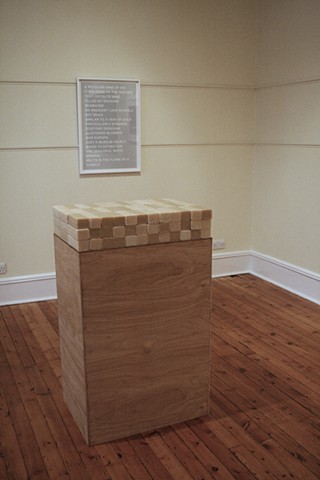
Soap Stack
2012
Soap, Plywood, Timber
The Greenlandic name for cryolite is Orsugiak. Inuits originally believed the mineral was a type of ice; it was possible to melt it in the flame of a candle. Orsugiak means 'glistening' or 'shiny', from the stem 'orsoq: fat, blubber'. Peterhead ships frequently carried cryolite from Ivittuut, Greenland, to Philadelphia, US, where it was used for the manufacturing of aluminum and soap. The ships associated with the cryolite trade were also often involved in the Baltic timber trade.
Campbell responded to the off-white cryolite mineral specimen that is exhibited in Arbuthnot Museum. The displayed mineral has a glistening, waxy, fat-like quality. The artist explored this materiality, using soap as a medium. The blocks of soap are stacked neatly, echoing the manner in which the excavated mineral was piled at Ivittuut, prior to shipment, and reflects upon the language of manufacturing in the town. In some literature it comments that the cryolite mineral was considered to be a curiosity and was gifted to many international institutions; it became something of a museum novelty. Systems of display in museums were also considered within the work, with the notion of cryolite being displayed on a plinth. The unfinished plywood plinth has references to the Baltic timber trade.
Campbell responded to the off-white cryolite mineral specimen that is exhibited in Arbuthnot Museum. The displayed mineral has a glistening, waxy, fat-like quality. The artist explored this materiality, using soap as a medium. The blocks of soap are stacked neatly, echoing the manner in which the excavated mineral was piled at Ivittuut, prior to shipment, and reflects upon the language of manufacturing in the town. In some literature it comments that the cryolite mineral was considered to be a curiosity and was gifted to many international institutions; it became something of a museum novelty. Systems of display in museums were also considered within the work, with the notion of cryolite being displayed on a plinth. The unfinished plywood plinth has references to the Baltic timber trade.





